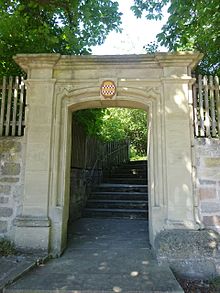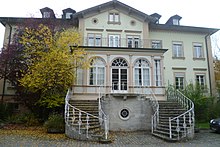Oberlauringen
|
Oberlauringen
Stadtlauringen market
Coordinates: 50 ° 12 ′ 58 ″ N , 10 ° 22 ′ 44 ″ E
|
||
|---|---|---|
| Height : | 325 m above sea level NN | |
| Incorporation : | May 1, 1978 | |
| Postal code : | 97488 | |
| Area code : | 09724 | |
|
Location of Oberlauringen in Bavaria |
||
With 680 inhabitants, Oberlauringen is part of the Stadtlauringen market in the Schweinfurt district of Lower Franconia .
Location
Oberlauringen lies at the foot of the 504 m above sea level. NN high foliage hill, the village is 325 m above sea level. NN . on the eaves of the Haßberge . The 33-kilometer Lauer rises on the Storchenbrünnle on the north-western edge of the village, below the Rabenberg . It is a station on the 2.4 km long Friedrich-Rückert-Rundweg. The Franconian Marienweg and the 143 km long Rückert hiking trail from Schweinfurt to Coburg run through Oberlauringen .
history
On May 1, 1978, the previously independent municipality was incorporated into the Stadtlauringen market.
Oberlauringen has been a Friedrich Rückert themed village since 2011 , in memory of the poet and orientalist Friedrich Rückert .
Up to 1943 Oberlauringen had a larger Jewish community with a synagogue, its own school, mikveh and cemetery. A Torah scroll recovered from the remains of the synagogue in Oberlauringen and hidden from the National Socialists was presented to the head of the Würzburg Israeli religious community, David Schuster, by Bishop Josef Stangl at the inauguration of the new Würzburg synagogue in 1970 . The former Federal Minister of Justice Gerhard Jahn and the rabbi and theology professor Leo Trepp had roots in Oberlauringen.
The place was in the domain of the Hochstift Würzburg. The Counts von Henneberg and von Wildberg, the Hutten von Birkenfeld and the Truchsesse zu Wetzhausen were enfeoffed. In 1811 the village fell back to the Grand Duchy of Würzburg and in 1814 to Bavaria.
Attractions
Oberlauringen Castle
A castle on a side line of the imperial knighthood of those of Truchseß zu Wetzhausen with a castle garden and a portal from the 18th century stands at the entrance to the village ( coming from Mailes ). After the death of Carl August Truchseß von Wetzhausen in 1811, Robert Karl Tunder (1832–1918), Imperial Russian Councilor in Helsingfors , bought the castle and had a new castle built in the style of a country villa in 1858.
In 1876 Georg Freiherr von Grunelius bought the castle and had it expanded by one floor. A landscape garden, the palace park, was laid out by the Frankfurt garden architect Heinrich Siesmayer .
Today the castle belongs to the deaconry association “Haus Gottesgüte e. V. Youth and Disabled Aid Oberlauringen ". The Friedenshort motherhouse in Freudenberg, Siegen (Siegerland) is still represented on the board of the Diakonieverein , because in 1946 Protestant deaconesses from the sisterhood from Miechowitz ( Kattowitz , Upper Silesia ), whose founder was Eva von Tiele-Winckler , found one with their orphans as refugees new home. The Diakonieverein Haus Gottesgüte maintains a boarding school and a school for youth and handicapped people on the grounds of the castle.
The Rückert gate
The Rückertpforte is located in the vicinity of the old town hall with its richly structured Franconian half-timbering. It is part of the former office of the Truchsess. It is reminiscent of Friedrich Rückert , who spent his youth in Oberlauringen from 1793. He describes this youth in his memoirs from the childhood of a village administrator's son , published in 1829.
The Protestant Church
The Evangelical Holy Spirit Church stands on a hill in the center of the village. It is a fortified church with a protective wall fortress and a two-story nave. Its origins go back to the 12th century.
The Jewish cemetery
The Jewish cemetery is located 500 meters west of the village . It was inaugurated in 1832 and has around 200 graves. The last funeral took place in 1938.
The Friedrich Rückert Poetic
The Friedrich Rückert Poetikum was opened in May 2017 . It shows the life and work of the poet and in particular the autobiographical memories of the poet's childhood and youth, which he spent from 1793 to 1802 as the son of the village official Johann Adam Rückert in Oberlauringen.
Infrastructure
One of the commercial areas of the municipality of Stadtlauringen is located in Oberlauringen. There is also a kindergarten, a primary school and a special school for learning and mentally disabled people.
Personalities
- Friedrich Rückert (1788–1866), poet and orientalist
- Jörg Geuder (1861–1935), teacher, poet, writer and language tutor, lived and worked in Oberlauringen for 22 years.
- Albrecht Eyring (1844–1920), fruit growing pioneer, member of the cooperative, founder of the Bavarian State Association for Fruit and Horticulture, honorary citizen of Herrnberchtheim, initiator of the Uffenheim Local History Museum, local researcher, pastor and church councilor, was born in Oberlauringen.
literature
- Friedrich Rückert: Memories from the childhood of a village official's son. 1829. Edited by Nora Zügel and Dagmar Stonus. Göttingen: Wallstein 2016, ISBN 978-3-8353-1793-2 .
- Norbert Bischoff: "The cheerful, wise garden uncle wrote 'rarely beautiful, good and rich'. The rewarding rediscovery of the teacher and garden writer Jörg Geuder". - Hans Michael Hensel (ed.): A touch of the theater world in the old tower on the Main. Hannes Fabig (1939–2008), set designer, actor, director, painter and tower keeper from Segnitz ("Feuilleton", issue 8). Segnitz: Zenos 2009, ISBN 3-931018-19-9 , pp. 31-35.
- Heinrich Reister: Plant a tree. Bad Windsheim 1984. (With a biography of Albrecht Eyring).
Web links
- Homepage of Oberlauringen (under construction)
- Market town of Stadtlauringen
- Friedrich Rückert Poetic
Individual evidence
- ^ Federal Statistical Office (ed.): Historical municipality directory for the Federal Republic of Germany. Name, border and key number changes in municipalities, counties and administrative districts from May 27, 1970 to December 31, 1982 . W. Kohlhammer GmbH, Stuttgart and Mainz 1983, ISBN 3-17-003263-1 , p. 753 .
- ↑ Klaus Witt City: church and state in the 20th century. In: Ulrich Wagner (Hrsg.): History of the city of Würzburg. 4 volumes, Volume I-III / 2, Theiss, Stuttgart 2001-2007; III / 1–2: From the transition to Bavaria to the 21st century. 2007, ISBN 978-3-8062-1478-9 , pp. 453–478 and 1304 f., Here: pp. 470–475 ( renewal in the spirit of the Second Vatican Council - Bishop Josef Stangl ). P. 470 f.
- ↑ Friedrich Rückert Poetikum








